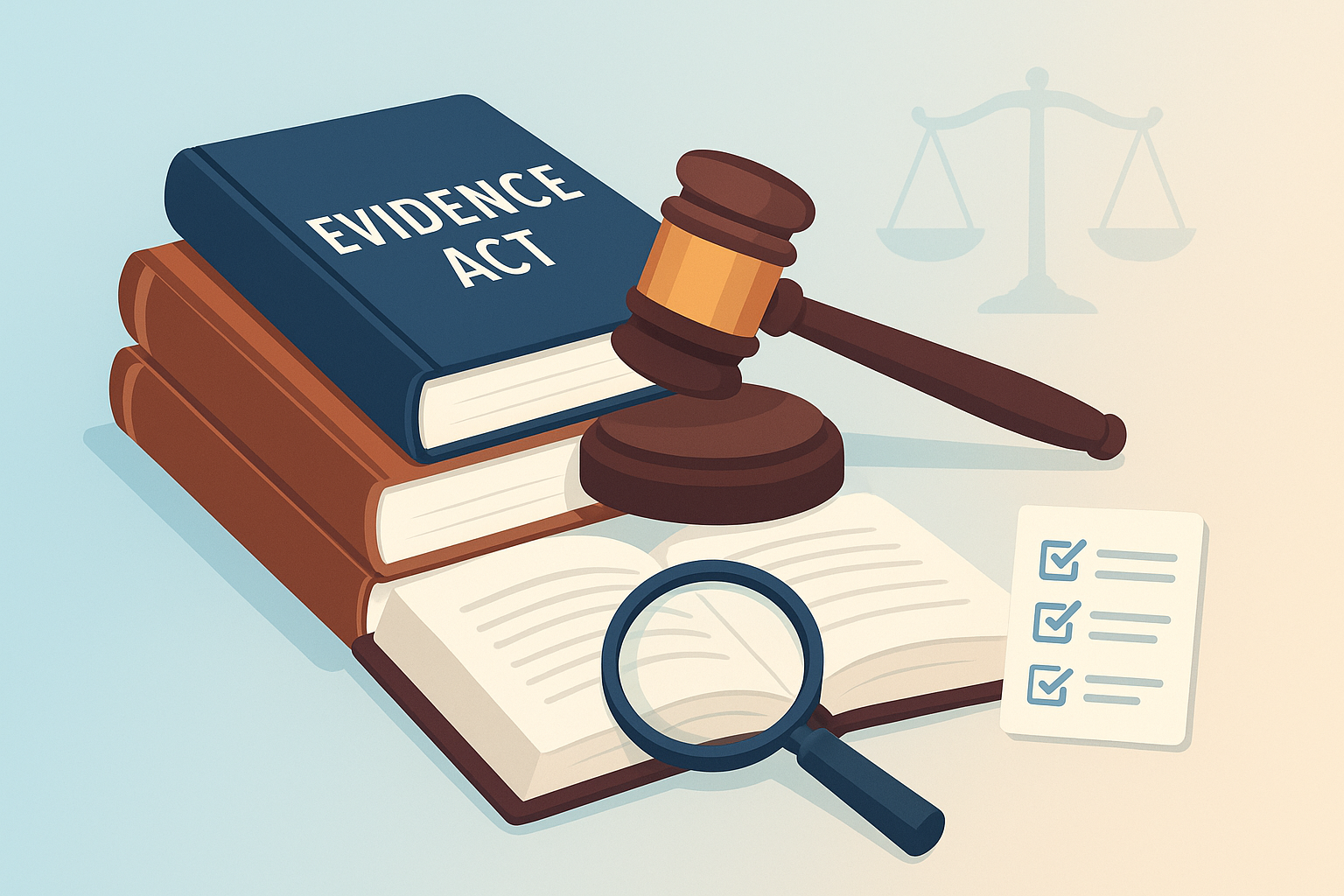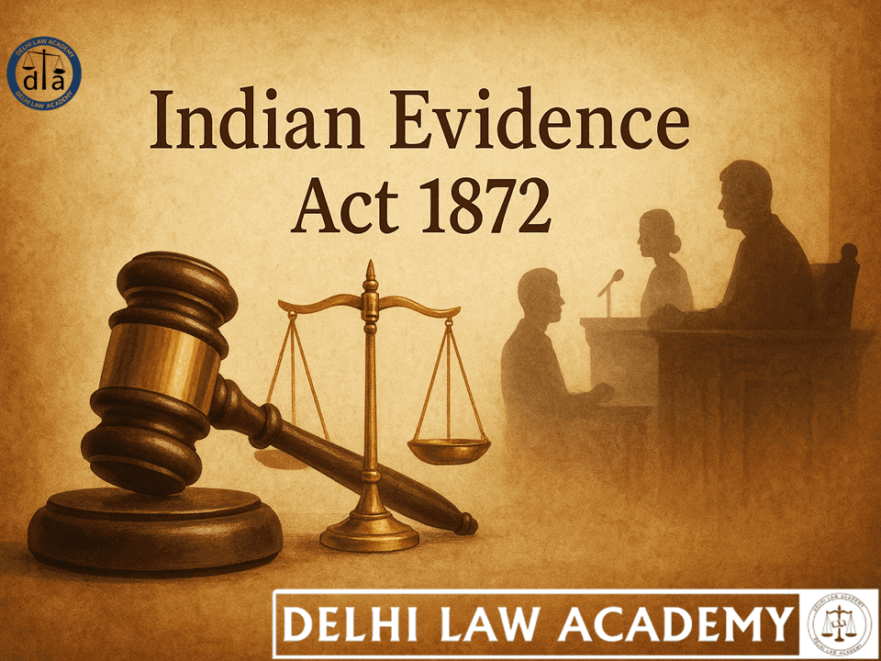
⚖️ Dying Declaration Explained Through Supreme Court
Key Questions
- What are the requirements of recording of a dying declaration?
- What are the requirements for a dying declaration to pass the test of reliability?
We now proceed to find answers to these questions from landmark judgments of the Supreme Court.
Evidence Act Explained – Part 9
The Evidence Act forms the bedrock of any and every Judicial Service exam in the country. Its thorough knowledge is a must for all aspirants of RJS, DJS, PCS (J) and every other Judicial Service exam. To help such aspirants, Delhi Law Academy Jaipur has launched a series of study material modules on all important aspects of this vital part of their syllabus.
📖 Section 32(1) Explained
Statements by person who is dead or cannot be found:
- Statements, written or verbal, on relevant facts made by a person who is dead are themselves relevant facts in the following cases:
- When the statement is made as to the cause of death or circumstances of the transaction which resulted in death, in cases where the cause of death comes into question.
- Such statements are relevant whether or not the person was under expectation of death when they were made.
📚 Case Study 1: Khushal Rao v. State of Bombay [1958 SC]
- This provision is an exception to the rule against hearsay, made as a matter of sheer necessity.
- Cross-examination tests veracity, but in dying declarations, solemn occasion replaces that safeguard.
- At the moment of impending death, a person is not expected to lie.
- To pass reliability, a dying declaration must be scrutinized closely, as it is made without cross-examination and in absence of accused.
🖊️ Recording of a Dying Declaration
Case 2: Laxman v. State of Maharashtra [2002 SC]
- No law requires dying declarations to be recorded only by a Magistrate.
- There is no statutory form prescribed for recording them.
- What is essential: the recorder must be satisfied that the deceased was in a fit state of mind.
- If proved that declarant was fit, even without doctor’s certification, declaration can be relied on if voluntary and truthful.
Conclusions from Laxman Case
- A dying declaration can be sole basis of conviction – corroboration is not an absolute requirement.
- Each case depends on its own facts and circumstances.
- Dying declaration is not a weaker form of evidence than others.
- It stands on equal footing with other evidence, to be weighed by standard rules.
- A declaration recorded by Magistrate in Q&A form in maker’s words has higher evidentiary value.
- Courts must check circumstances of observation, e.g.:
• whether there was sufficient light if crime was at night
• whether memory was unimpaired
• whether statements were consistent if made multiple times
• whether it was made promptly without tutoring
⚖️ Circumstances of the Transaction Resulting in Death
Case 3: Sudhakar v. State of Maharashtra [2000 SC]
- Dying declaration carries weight due to maxim nemo moriturus praesumitur mentiri (a man will not meet his maker with a lie).
- Unlike English law, Section 32 does not require expectation of death.
- Statements must be proximate to the actual occurrence of death.
- Statements like going to the place of death, meeting a person, or being invited are all admissible as circumstances of the transaction.
- They may even be exculpatory of the accused.
Case 4: Patel Hiralal Joitaram v. State of Gujarat [2002 SC]
- The words “statement as to any of the circumstances” broaden admissibility greatly.
- When linked with “transaction which resulted in death”, the scope is very wide.
- Anything with a nexus to death, direct/indirect, proximate/distant, may be admissible.
- Since the maker is deceased, courts should include rather than exclude relevant statements.
- First step: admissibility. Next: test reliability. Then: determine utility in the case.
📚 Continue Your Evidence Act Preparation
Don’t stop here! Strengthen your knowledge of the Evidence Act with our other fully solved tests:
📘 Free Study Material for Judiciary Aspirants!
Download our FREE study material prepared by Delhi Law Academy’s expert faculty.
❓ Frequently Asked Questions
A confession is a direct acknowledgment of guilt and is governed by Sections 24–30. Confessions face stricter admissibility rules, especially if made under inducement, to police officers, or in custody.
The only exception is when they are made in the immediate presence of a Magistrate.
But a confessional FIR given to a police officer cannot be used against the accused due to the bar in Section 25 of the Evidence Act.
- Made under inducement, threat, or promise (Section 24)
- Made to a police officer (Section 25)
- Made while in police custody, unless in presence of Magistrate (Section 26)
However, Section 27 allows discovery of facts to be proved from accused’s statements.
They test: admissibility, rationale behind inadmissibility, exceptions, and landmark case laws such as:
- Veera Ibrahim v. State of Maharashtra (1976)
- Aghnoo Nagesia v. State of Bihar (1966)
- Pulukuri Kottaya v. Emperor (Privy Council)
- An admission is generally admissible against its maker under Section 21.
- A confession faces stricter admissibility filters and may not be admitted if made under prohibited circumstances.
- Confessions can be used against co-accused (Section 30), while admissions cannot.
Thus, it directly affects the scope of evidence available in trials.
Contact us
📍 Delhi Law Academy – Jaipur Branch
6C, Tower 2, Coaching Hub, Pratap Nagar, Jaipur – 302033
📞 Phone:
+91 9911916552
+91 8447285606
✉️ Email:
contactus@delhilawacademy.com

